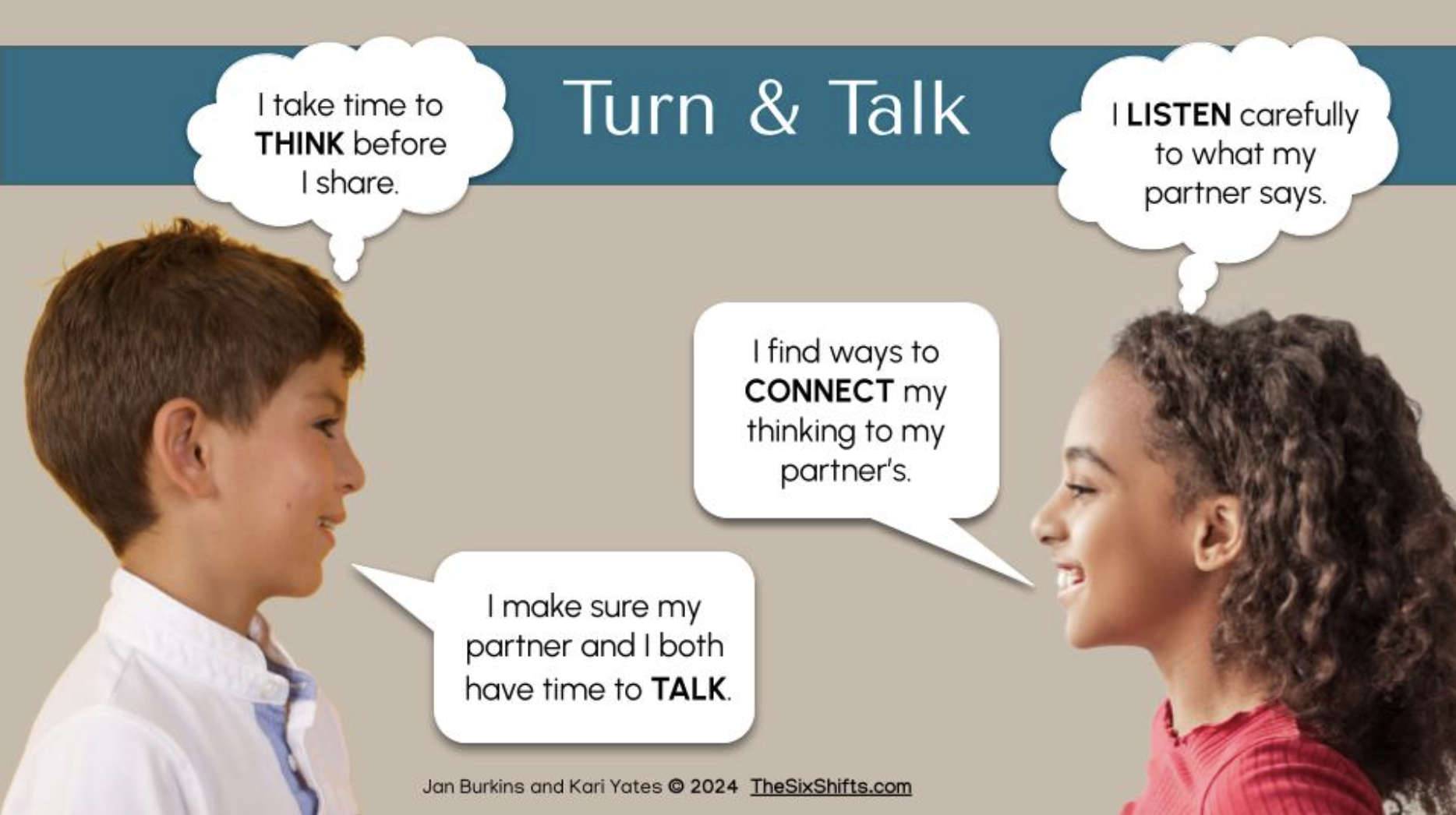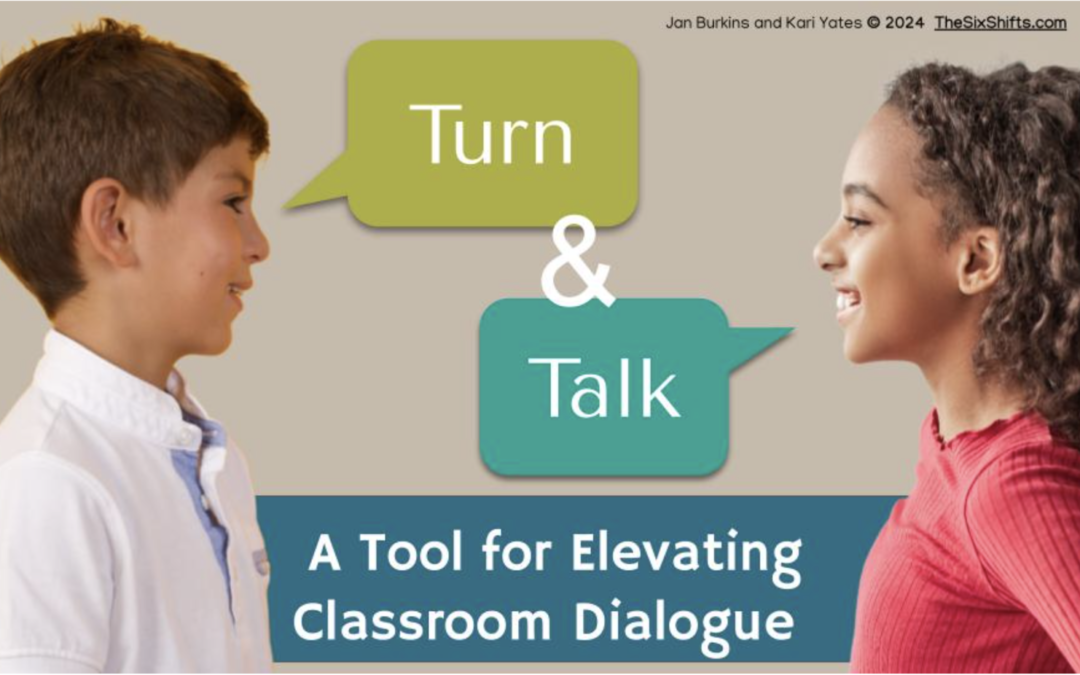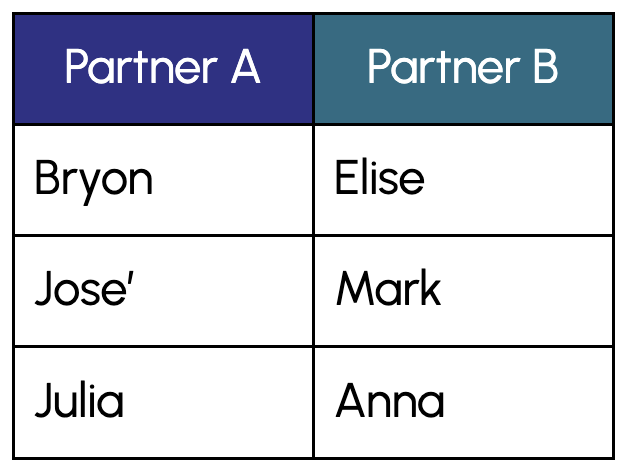We’re confident you’re already familiar with Turn and Talk; it’s perhaps one of the most widely known yet underutilized instructional strategies. But given its simplicity and power, we wanted to invite you to brush up on this classic and maybe sprinkle in a few new twists to make it even more effective.
Turn and Talk isn’t just a classroom activity—it’s a chance for students to regularly stretch and build their language muscles in a comfortable, supportive setting. And it’s not just about turning and talking—it’s also about one more “T”—thinking!
What’s Turn and Talk All About?
Picture this: two students sit side-by-side, entertaining a thought-provoking question from you. They turn to each other and dive into a mini conversation, each sharing their thinking and responding to what the other offers. Meanwhile, you selectively listen in to a number of different partnerships, gathering formative data, making anecdotal notes, and positioning yourself for better-informed next steps. After all, you haven’t just heard from one or two eager beavers. You’ve gotten a cross-sampling of the thinking of a number of students.
Why We Love Turn and Talk
There are lots of reasons to embrace Turn and Talk as a consistent tool for oral language development and classroom engagement. Here are just a few of our favorites:
- Everyone Gets a Voice: It’s not just the quick hand-raisers who get to speak; every single student gets a moment to shine with their partner. Everyone is engaged and accountable.
- Teachers Tune In: While students chat, you get a golden opportunity to listen in and really hear what students are thinking. This formative data helps you know what they know and where they need more support.
- Confidence Grows: For quieter students, Turn and Talk provides a safe space to express their thoughts without the spotlight of speaking in front of the whole class.
- Children Learn to Listen: Turn and Talk isn’t just practice in summing up their thoughts. It also requires students to actively listen to a partner, connecting their partner’s thinking to their own and vice versa.
- Reset for the brain: We all know that too much teacher talk without a break for processing can easily become counterproductive. Turn and Talk provides an authentic brain reset without losing learning momentum, and summing up ideas in their own words is an important part of comprehending the lesson.
Setting Up for Success: How to Make The Most of Turn and Talk
Imagine your fourth-grade students are studying extreme weather. You want them to “turn on what they know” about storms before reading the narrative poem “Twister Hits Houston” by Sandra Sisneros. So you say, “Take a moment to think about the ways humans are affected by serious weather events. In a moment, you’ll turn and talk with a partner. ”
But what happens next depends on the groundwork you’ve already laid.
The work of maximizing Turn and Talk conversations begins before you prompt students to actually turn and talk. Children have to learn the routines for engaging in meaningful conversations with peers. So, what are some essentials to remember? We offer a few important considerations below:
1. Thoughtful Pairing: Take time to think about who might best partner with whom. Assigning partners is not only efficient, but it also eliminates uncertainty and social anxiety. These pairs may take some adjusting as you get to know your new students better, but having a set partner can eliminate some confusion and some social pressure. Of course, set partnerships don’t need to be permanent, and students can have different partners for different situations. However, mixing students’ thoughts can make a big difference. For example, you might:
-
- Pair chatty students together so they learn to share the stage.
- Team up two quieter students so they can find their voices together.
- Avoid pairing two students who both have difficulty staying on task.
- Pair students who are new to English with peers who share the same home language.
2. Visible Partnership Lists: Help everyone remember who their partner is by putting a simple chart up on the wall. You can even designate A and B partners (blue and gold, hamburgers and fries, etc.), which can give you a tag for helping students get started and learn to share the air. Once these tags are assigned, you can prompt students by saying something like,
“Partner A will be the first to share their thinking.
Partner B will be the first to listen, sum up, and respond.”
3. Clear Expectations: Paint a clear picture of success for your students. Consider creating an anchor chart together that lays out what makes a great conversation partner. Include specifics, such as what active listening looks like and what staying on topic sounds like.

4. Time to Think: Before having students dive into their conversations with partners, offer everyone a moment to prepare their thinking. Asking every student to mentally prepare to answer the question gives them an equal opportunity to participate in the exchange. This set think-time also lets your quick responders cool their jets for a minute so that those who need some processing time can get their thoughts in order. Think time matters, and offering it consistently will elevate your classroom conversations.
5. Connecting the Dots: There’s a difference between just talking and having a meaningful conversation. Conversations are connected in ways that indicate the partners are tuned in to each other’s contributions. Students will benefit from modeling, practice, and scaffolds to help them connect the dots in their conversations. For instance, you might provide students with a mini-chart that includes specific sentence stems for different types of responses:
-
- Honoring: “Thank you for sharing . . . “
- Summing Up: “What I heard you say is . . . “
- Agreeing: “I agree with what you said about . . . “
- Disagreeing: “I disagree because . . .”
- Alternate Perspective: “I thought about it differently because . . . “
- Adding On: “I would like to add on to what you said about . . . “
- Questioning: “I’m not sure I understand. Will you please clarify what you said about . . .?”
6. Engaging Questions: Strong, open-ended questions can spark some amazing conversation. But when questions fall flat, so does the conversation. So, go for open-ended questions that invite students to think deeply and use academic language to express their ideas. For example:
-
- “What surprises you about . . . ? Why?”
- “What are you noticing about . . . ?”
- “What factors contributed to . . . ? How do you know?”
- “Explain why you agree or disagree.”
- “What are you still wondering about? Why?”
7. Data Gathering: Circulate and listen in, but keep your presence minimal and let students lead the conversation. No doubt, you will see much that students need to practice and improve, but think of this as a formative assessment. You might even grab a clipboard with a list of your students’ names and a space for notes (here’s a sample). You can come up with a rating scale, such as 1-5, indicating the quality of the conversation, the depth of thought, or the connection between the partners. You might capture phrases or academic language students use. Spending just a couple of minutes listening to just a few students each time will quickly give you a lot of insight into how to support all students in becoming better at Turn and Talk.
8. Wise Timing: Another advantage of listening and watching rather than participating in conversations is that you will be able to see when conversations begin to wane. Once students begin to talk, keep it brief. Given too much time to respond, even the most well-intentioned participants can drift off-topic. Call time while conversations are still successful.
9. Ongoing Practice: Of course, Turn and Talk routines are not something we can teach once and then forget about. A commitment to this classic routine requires the investment of time, energy, and patience. But with consistency, practice, and feedback your students can become successful Turn and Talk partners across the learning day.
The beginning of the school year is the perfect time to introduce and practice the routines that will set your students up for a year of success. To build Turn and Talk skills in the fall while helping students get to know each other as people, you might start with prompts aimed at doing just that. (Who are the important people in your life outside of school? What do you hope to learn about this year?) If you’d like a list of some prompts for this very purpose, you can get that here.
But, whether at the beginning year, middle or near the end of the year, any time can be the right time to refresh Turn and Talk routines. And as students become increasingly skilled in talking with each other about what they are learning, you can extend their practice by teaching them how to repeat and expand on what their partner says or to ask open-ended questions themselves.
Best of all, as your students get more comfortable with their Turn and Talk conversations, you’ll see those skills popping up in other parts of their day, too. Turn and Talk isn’t just about learning to have focused conversations—it’s about building a community of thoughtful, engaged learners.
Let’s get them talking, listening, and responding to each other.





Thank you for ‘turn and talk’.
I’ll try it with my new k class in September. Of course, it will be hard for them but is worth a try for a minute or two.
Reminds me of ‘think, pair share’.
I really appreciate all your help with literacy learning.
Thank you for this supplement class to the book. The details improve understanding of the program. Thank you for making it on our own timeline and online.